Reviewer's Note: This is a review of the EagleTac P10C (1xCR123A/RCR) light. The P10C was purchased from lighthound.com, but I know 4sevens is also offering them at EagleTac-store.com.
EagleTac is a new arrival on the flashlight scene. Although their various builds seem superficially reminiscent of a few other makers (most especially Olight), there are a number of distinctive features. Circuity is also interesting, as these are simple 2-stage lights (e.g. reminiscent of the Fenix LxT series, mode switching performed by a head twist). How does the 1xCR123A/RCR P10C light stack up to the competition? Scroll down and see ...
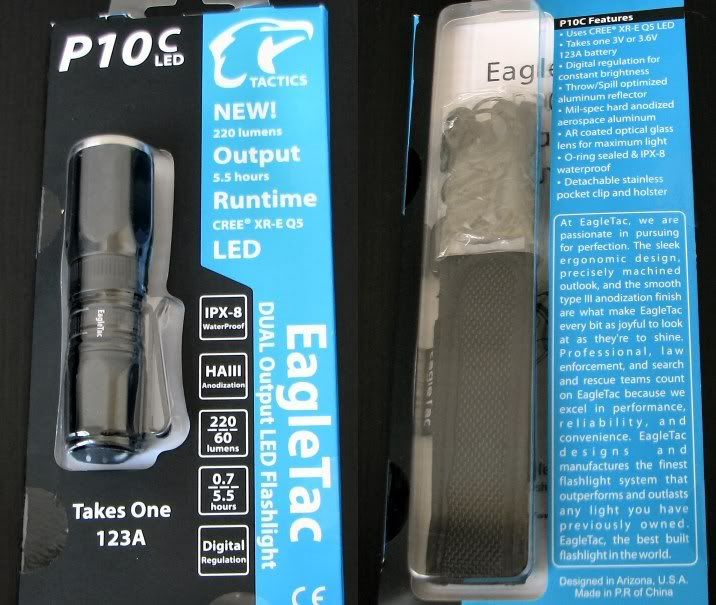
Packaging is very reminiscent of current Surefire packaging.

Light comes with a removable bi-directional pocket clip, manual, extra o-ring, extra switch boot cover and wrist lanyard.
UPDATE: Some users have reported removing the clip on Eagletac lights can scratch the anodizing in the clip ring groove. But I've found that adding a little teflon oil lube to the area first reduces the risk.
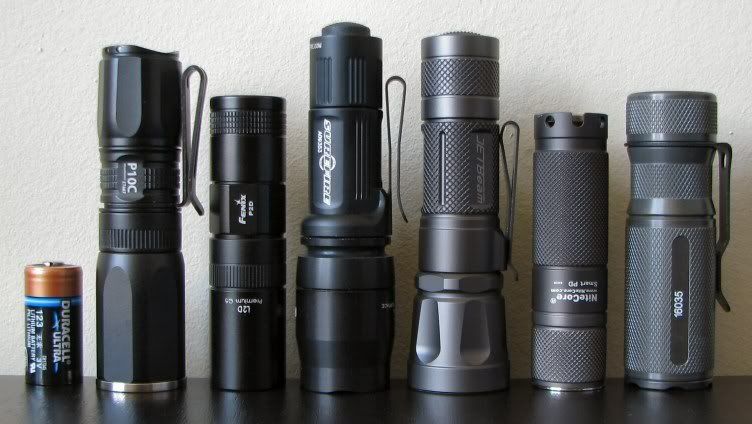
As you can see, size fits in pretty well with the larger 1xCR123A/RCR lights.
Weight: 67.0g
Length: 94mm
Width: 26mm at the head, 23mm at the tailcap

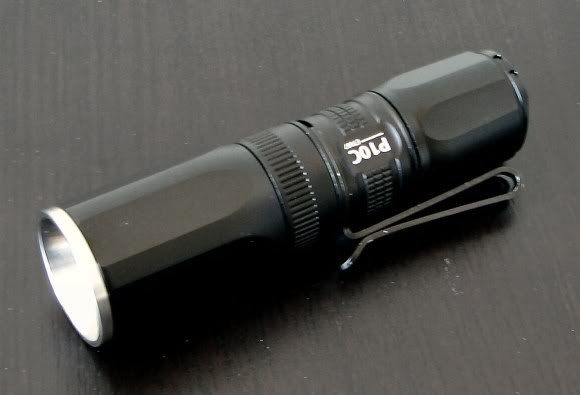
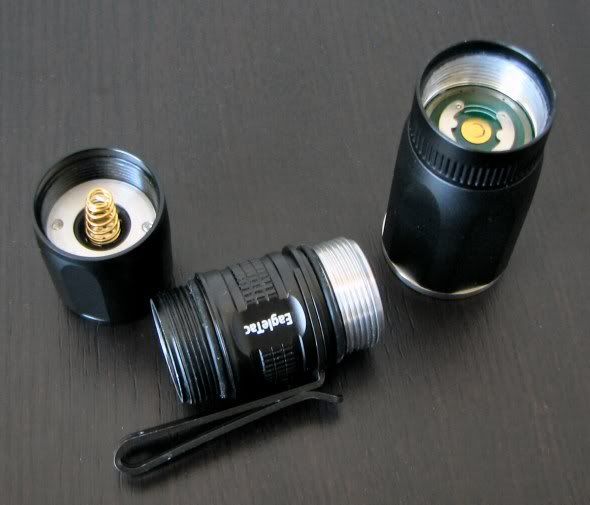
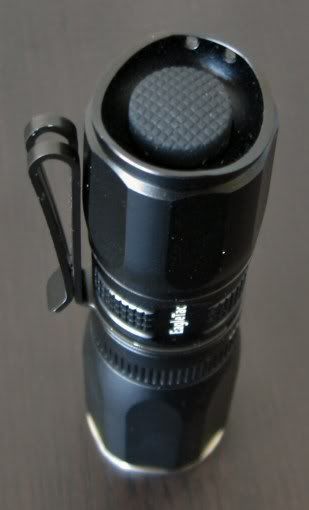
The P10C is of very high quality. All components feel very sturdy, and everything fits together well. Screws threads are top-notch, and very smooth. Tailcap threads are anodized, allowing tailcap lockout. Hand feel is excellent. Light can tailstand, and comes with a forward clicky. A real stand-out. :thumbsup:
Lettering is remarkably sharp and clear. Type-III anodizing is perfect throughout the body of the light - although it is somewhat worn off along one edge of the clip on my sample.
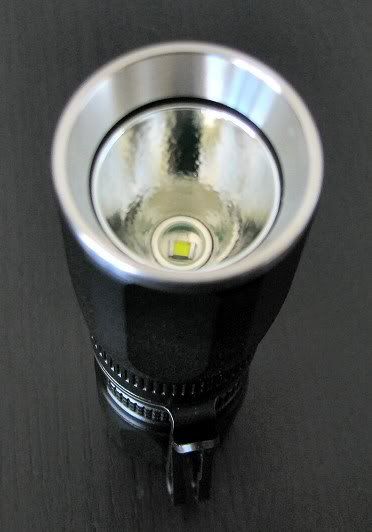
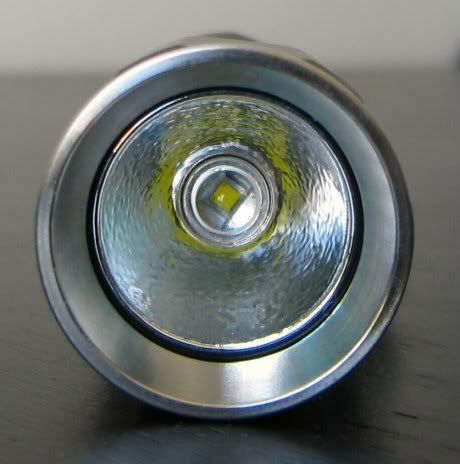
The light features an attractive stainless steel bezel ring, and the head assembly seems of high quality. The reflector is very deep, with what I would describe as a light orange-peel texturing (LOP). Interestingly, there's a greenish tinge when looking at the reflector, most noticeable when the light is on:
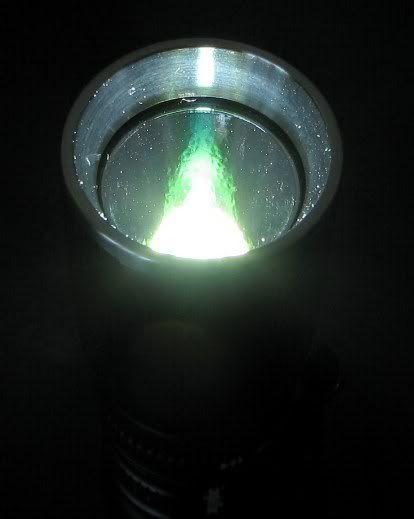
This is likely due to the anti-reflective coating on the lens - but it doesn't seem to affect beam tint appreciably. The deeper reflector and low level of texturing should translate into decent throw. To get an idea, here are a few beamshots - below is a comparison to the Fenix P2D (Q5) and JetBeam Jet-II IBS, all lights on max (pics taken ~0.5 m from a white wall).
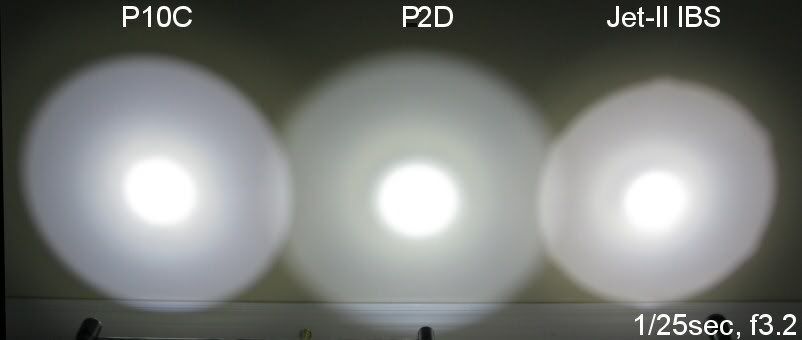
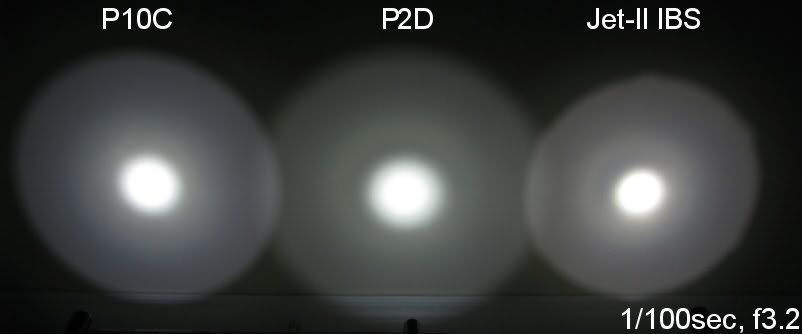
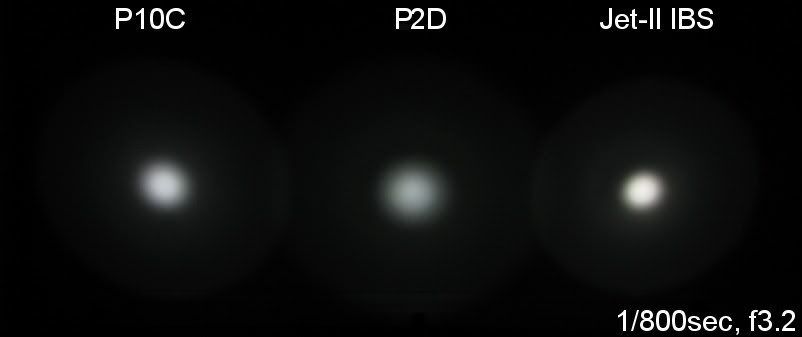
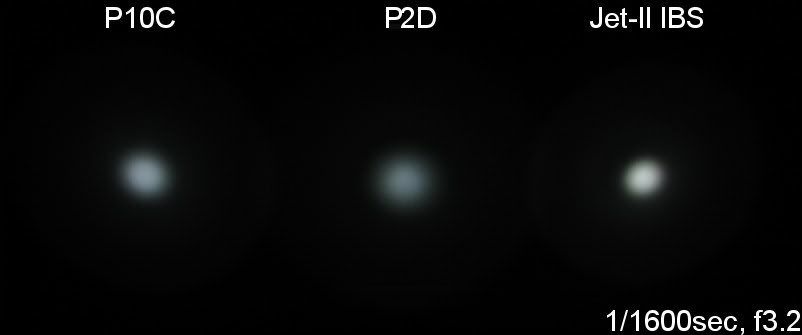
As you see in the pics, the P10C throws very well – better than the P2D, but not as well as the Jet-II. Surprisingly for a light OP, it also has a very nice beam profile with minimal Cree rings. For a more detailed throw/output comparison, see my Summary chart below.
Testing Method: All my output numbers are relative for my home-made light box setup, a la Quickbeam's flashlightreviews.com method. You can directly compare all my relative output values from different reviews - i.e. an output value of "10" in one graph is the same as "10" in another. All runtimes are done under a cooling fan, except for the extended run Lo/Min modes which are done without cooling.
Throw values are the square-root of lux measurements taken at 1 meter from the lens, using a light meter.
Throw/Output Summary Chart:
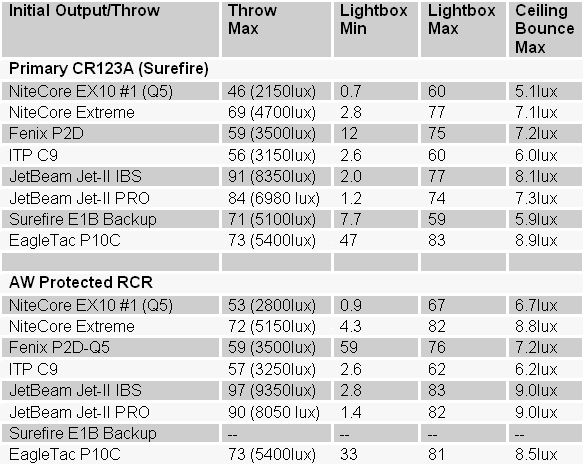
As suggested by the beamshots, throw on the P10C is very good – it rivals that of my Surefire E1B and NiteCore Extreme. The Jet-II lights (also OP reflectors) remain the throw champions, however.
Overall output is quite interesting. The P10C is very close to the max output of the NiteCore Extreme and Jet-II IBS/PRO on RCR (although my Jet-II IBS still has a slight edge).
On primary CR123A, there is no contest – the P10C is the clear winner. Simply put, the P10C's initial output on CR123A is even slightly higher than its RCR output. That's a new one for me - it is certainly something none of the other contenders can match.
That's a new one for me - it is certainly something none of the other contenders can match.
Of course, I expect this will result in a significant runtime reduction as a trade-off ...
Output/Runtime Comparison:

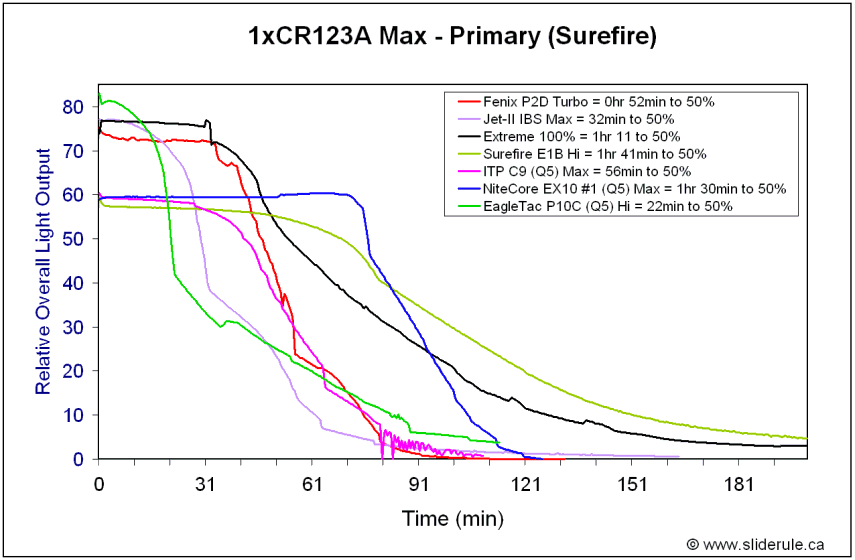
... and it does. As you can see, runtime for the P10C on CR123A is the lowest of any of my 1xCR123A lights. This is not surprising – something has to give for that kind of output. Its RCR runtime performance is quite respectable, though.
As you can see, runtime for the P10C on CR123A is the lowest of any of my 1xCR123A lights. This is not surprising – something has to give for that kind of output. Its RCR runtime performance is quite respectable, though.
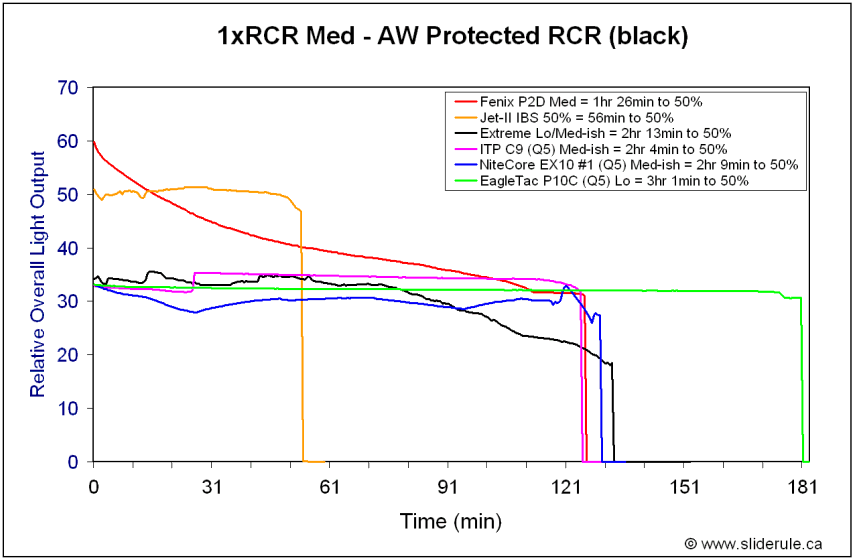
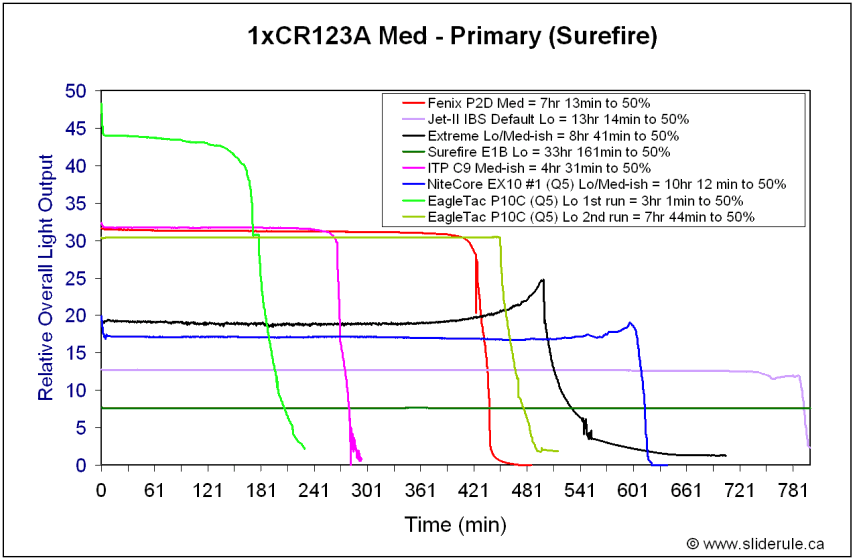
UPDATE SEPT 30, 2008: Upon further testing, it seems I've managed to elicit 2 distinct "Lo" output levels on primaries (shown as 1st run and 2nd run above). Although I've managed to get the higher 1st run output (i.e. ~50 on my scale) a couple of times, most of the time the light has produced 2nd run output (i.e. ~30 on my scale). See the end of this post for a discussion.
The "Lo" mode of the P10C is really anything but – output is typically comparable to Med on most lights. On RCR, "Lo" is about 40% of Hi output, and with very impressive runtime. The light is clearly current-controlled to achieve that kind of performance.
– output is typically comparable to Med on most lights. On RCR, "Lo" is about 40% of Hi output, and with very impressive runtime. The light is clearly current-controlled to achieve that kind of performance. 
On CR123A, "Lo" is typically also ~40% of Hi - although I've also elicited a ~60% "Lo" mode on couple of occasions (see discussion at the end of this post). Performance for the expected ~40% output level is also quite good.
Although hard to see on the graphs, the light seems to have a low voltage flash to indicate a nearly depleted cell. Looks something like a repeated flicker.
Potential Issues
A couple of minor issues popped up during my testing. Once when switching from Hi to Lo on a new CR123A battery, the light mysteriously dropped to a very low level (far less than normal Lo). It refused to jump back to normal Lo/Hi levels, even after removing and re-installing the primary cell. The light started working normally again after inserting an RCR – after that, the original primary CR123A worked as expected (see end of this post for a further discussion).
Another time, near the end of a CR123A run, the light suddenly began flickering badly (continuously, in a separate manner from the low voltage flicker). Simply handling the light (i.e. picking it up and looking it over) caused it to start behaving normally again.
These two incidents suggest some sort of intermittent contact problem. I've given the light a thorough cleaning, so hopefully I won't see any more of these. I'll keep you posted if the problems persist.
General Observations
EagleTac has certainly impressed with the build quality of this little light. oo: For a relatively unknown company, their first offerings seem to have been designed with great care and thought. I really can't find much to fault on the P10C build, except perhaps that the forward clicky is stiffer than most - and the clip gets in the way somewhat of easily tightening the tailcap. Other than that, it is a pleasure to hold and use.
oo: For a relatively unknown company, their first offerings seem to have been designed with great care and thought. I really can't find much to fault on the P10C build, except perhaps that the forward clicky is stiffer than most - and the clip gets in the way somewhat of easily tightening the tailcap. Other than that, it is a pleasure to hold and use.
Output/performance design is a bit unusual. On Hi, EagleTac definitely seems to be targeting the "Damn the torpedoes! Full speed ahead!" audience. :laughing:
While my Jet-II IBS was marginally brighter on RCR, I believe the P10C really matches the Jet-II and NiteCore Extreme (not EX10) for maximal output on Li-ions. Considering the variability of individual emitters, you could easily have any one of these 3 lights outperform the others by a slight margin, in a given sample.
Where there is no question is on 1xCR123A – the P10C was the clear output king. Of course, that comes with a price – the P10C has the lowest runtime on 1xCR123A of any of my lights.
Of course, that comes with a price – the P10C has the lowest runtime on 1xCR123A of any of my lights.
The second unusual feature is the "low" mode, which at ~40% of max output is high enough to qualify as Med on most lights. I would think a better descriptor for this light is not Lo/Hi, but a "power-saving" Regular mode and a Turbo mode. While runtime on RCR and CR123A was excellent for this "low" level, the lack of anything actually approaching a real "low" is disappointing. At least the circuit seems well optimized for performance at these levels.
Given the very high build quality, I would be very interested to see what EagleTac could do with more versatile circuit. The amount of throw and smooth spill on such a relatively small reflector/head design is particularly impressive. Not to overdo the pun, but I would think EagleTac should have a bright future in this business ...
----------------------------
UPDATE SEPT 30, 2008:
Ok, I think I've figured out what is going on with the Lo mode on primaries. Initially, I was getting inconsistent results - sometimes Lo mode was ~60% of max output, sometimes it was ~40% of max output. I was also getting a strange unexplained extremely low mode (<3%) a couple of times after switching primaries - something that was only cured by swapping in a RCR.
After a thorough cleaning of the light with deoxit on all contact surfaces, I am now only getting the ~40% output level consistently. Based on the RCR results and the reports of others, this seems to be the appropriate Low level.

I am not sure where the ~60% output level was coming from, but I was able to reliably reproduce it half a dozen times at first. Note that I never got an intermediate value - it was either ~60% or ~40% each time I tried (except for the strange <3% mode that occurred twice). I'm just guessing here, but I wonder if the circuit doesn't have a few extra disabled modes that were somehow accidentally triggered by a contact problem (e.g. like the mysterious SOS mode on the Lumapower Incendio)? :thinking:
A second point is that I was commonly changing the battery by removing the head, since the tailcap is difficult to tighten fully with the protruding clip in the way. I'm wondering if that wasn't contributing to "confusing" the circuit somewhat when switching batteries (i.e. somewhat like the Novatac 120P - most of the time I can switch between RCR and primaries without problem, sometimes I need to do the battery mode reset once or twice to get it working properly). I am now switching the battery only at the tailcap, and have not experienced any more mysterious modes.
I will let you know if it stays this way - but I'm curious is anyone else has experience these issues?
EagleTac is a new arrival on the flashlight scene. Although their various builds seem superficially reminiscent of a few other makers (most especially Olight), there are a number of distinctive features. Circuity is also interesting, as these are simple 2-stage lights (e.g. reminiscent of the Fenix LxT series, mode switching performed by a head twist). How does the 1xCR123A/RCR P10C light stack up to the competition? Scroll down and see ...

Packaging is very reminiscent of current Surefire packaging.

Light comes with a removable bi-directional pocket clip, manual, extra o-ring, extra switch boot cover and wrist lanyard.
UPDATE: Some users have reported removing the clip on Eagletac lights can scratch the anodizing in the clip ring groove. But I've found that adding a little teflon oil lube to the area first reduces the risk.

As you can see, size fits in pretty well with the larger 1xCR123A/RCR lights.
Weight: 67.0g
Length: 94mm
Width: 26mm at the head, 23mm at the tailcap




The P10C is of very high quality. All components feel very sturdy, and everything fits together well. Screws threads are top-notch, and very smooth. Tailcap threads are anodized, allowing tailcap lockout. Hand feel is excellent. Light can tailstand, and comes with a forward clicky. A real stand-out. :thumbsup:
Lettering is remarkably sharp and clear. Type-III anodizing is perfect throughout the body of the light - although it is somewhat worn off along one edge of the clip on my sample.


The light features an attractive stainless steel bezel ring, and the head assembly seems of high quality. The reflector is very deep, with what I would describe as a light orange-peel texturing (LOP). Interestingly, there's a greenish tinge when looking at the reflector, most noticeable when the light is on:

This is likely due to the anti-reflective coating on the lens - but it doesn't seem to affect beam tint appreciably. The deeper reflector and low level of texturing should translate into decent throw. To get an idea, here are a few beamshots - below is a comparison to the Fenix P2D (Q5) and JetBeam Jet-II IBS, all lights on max (pics taken ~0.5 m from a white wall).




As you see in the pics, the P10C throws very well – better than the P2D, but not as well as the Jet-II. Surprisingly for a light OP, it also has a very nice beam profile with minimal Cree rings. For a more detailed throw/output comparison, see my Summary chart below.
Testing Method: All my output numbers are relative for my home-made light box setup, a la Quickbeam's flashlightreviews.com method. You can directly compare all my relative output values from different reviews - i.e. an output value of "10" in one graph is the same as "10" in another. All runtimes are done under a cooling fan, except for the extended run Lo/Min modes which are done without cooling.
Throw values are the square-root of lux measurements taken at 1 meter from the lens, using a light meter.
Throw/Output Summary Chart:

As suggested by the beamshots, throw on the P10C is very good – it rivals that of my Surefire E1B and NiteCore Extreme. The Jet-II lights (also OP reflectors) remain the throw champions, however.
Overall output is quite interesting. The P10C is very close to the max output of the NiteCore Extreme and Jet-II IBS/PRO on RCR (although my Jet-II IBS still has a slight edge).
On primary CR123A, there is no contest – the P10C is the clear winner. Simply put, the P10C's initial output on CR123A is even slightly higher than its RCR output.
Of course, I expect this will result in a significant runtime reduction as a trade-off ...
Output/Runtime Comparison:


... and it does.


UPDATE SEPT 30, 2008: Upon further testing, it seems I've managed to elicit 2 distinct "Lo" output levels on primaries (shown as 1st run and 2nd run above). Although I've managed to get the higher 1st run output (i.e. ~50 on my scale) a couple of times, most of the time the light has produced 2nd run output (i.e. ~30 on my scale). See the end of this post for a discussion.
The "Lo" mode of the P10C is really anything but
On CR123A, "Lo" is typically also ~40% of Hi - although I've also elicited a ~60% "Lo" mode on couple of occasions (see discussion at the end of this post). Performance for the expected ~40% output level is also quite good.
Although hard to see on the graphs, the light seems to have a low voltage flash to indicate a nearly depleted cell. Looks something like a repeated flicker.
Potential Issues
A couple of minor issues popped up during my testing. Once when switching from Hi to Lo on a new CR123A battery, the light mysteriously dropped to a very low level (far less than normal Lo). It refused to jump back to normal Lo/Hi levels, even after removing and re-installing the primary cell. The light started working normally again after inserting an RCR – after that, the original primary CR123A worked as expected (see end of this post for a further discussion).
Another time, near the end of a CR123A run, the light suddenly began flickering badly (continuously, in a separate manner from the low voltage flicker). Simply handling the light (i.e. picking it up and looking it over) caused it to start behaving normally again.
These two incidents suggest some sort of intermittent contact problem. I've given the light a thorough cleaning, so hopefully I won't see any more of these. I'll keep you posted if the problems persist.
General Observations
EagleTac has certainly impressed with the build quality of this little light.
Output/performance design is a bit unusual. On Hi, EagleTac definitely seems to be targeting the "Damn the torpedoes! Full speed ahead!" audience. :laughing:
While my Jet-II IBS was marginally brighter on RCR, I believe the P10C really matches the Jet-II and NiteCore Extreme (not EX10) for maximal output on Li-ions. Considering the variability of individual emitters, you could easily have any one of these 3 lights outperform the others by a slight margin, in a given sample.
Where there is no question is on 1xCR123A – the P10C was the clear output king.
The second unusual feature is the "low" mode, which at ~40% of max output is high enough to qualify as Med on most lights. I would think a better descriptor for this light is not Lo/Hi, but a "power-saving" Regular mode and a Turbo mode. While runtime on RCR and CR123A was excellent for this "low" level, the lack of anything actually approaching a real "low" is disappointing. At least the circuit seems well optimized for performance at these levels.
Given the very high build quality, I would be very interested to see what EagleTac could do with more versatile circuit. The amount of throw and smooth spill on such a relatively small reflector/head design is particularly impressive. Not to overdo the pun, but I would think EagleTac should have a bright future in this business ...
----------------------------
UPDATE SEPT 30, 2008:
Ok, I think I've figured out what is going on with the Lo mode on primaries. Initially, I was getting inconsistent results - sometimes Lo mode was ~60% of max output, sometimes it was ~40% of max output. I was also getting a strange unexplained extremely low mode (<3%) a couple of times after switching primaries - something that was only cured by swapping in a RCR.
After a thorough cleaning of the light with deoxit on all contact surfaces, I am now only getting the ~40% output level consistently. Based on the RCR results and the reports of others, this seems to be the appropriate Low level.

I am not sure where the ~60% output level was coming from, but I was able to reliably reproduce it half a dozen times at first. Note that I never got an intermediate value - it was either ~60% or ~40% each time I tried (except for the strange <3% mode that occurred twice). I'm just guessing here, but I wonder if the circuit doesn't have a few extra disabled modes that were somehow accidentally triggered by a contact problem (e.g. like the mysterious SOS mode on the Lumapower Incendio)? :thinking:
A second point is that I was commonly changing the battery by removing the head, since the tailcap is difficult to tighten fully with the protruding clip in the way. I'm wondering if that wasn't contributing to "confusing" the circuit somewhat when switching batteries (i.e. somewhat like the Novatac 120P - most of the time I can switch between RCR and primaries without problem, sometimes I need to do the battery mode reset once or twice to get it working properly). I am now switching the battery only at the tailcap, and have not experienced any more mysterious modes.
I will let you know if it stays this way - but I'm curious is anyone else has experience these issues?
Last edited:


 If a friend of mine hadn't noticed, it would still be sitting with the leaf litter. Since then, I only the carry the E1B bezel down in a pocket.
If a friend of mine hadn't noticed, it would still be sitting with the leaf litter. Since then, I only the carry the E1B bezel down in a pocket. 


